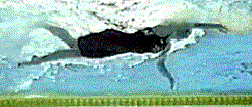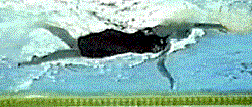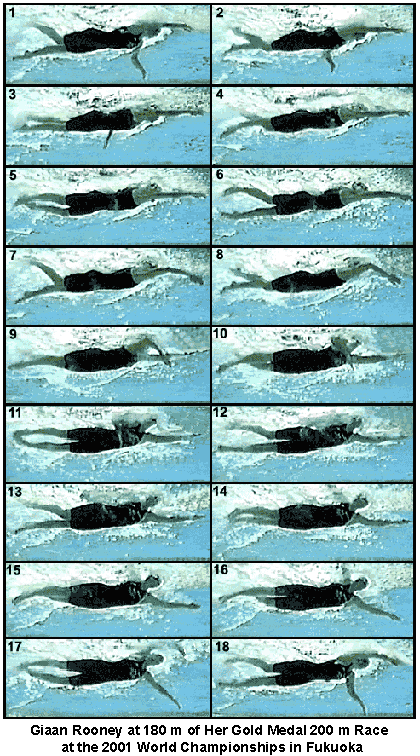HOW CHAMPIONS DO IT
Researched, produced, and prepared by Brent S. Rushall,
Ph.D., R.Psy.

GIAAN ROONEY AT 180 m OF HER GOLD MEDAL 200 m FREESTYLE RACE AT THE 2001 WORLD CHAMPIONSHIPS IN FUKUOKA
Each frame is .1 seconds apart. Giaan Rooney's time for this race was 1:58.57.
This stroke analysis includes a moving sequence in real time, a moving sequence where each frame is displayed for .5 of a second, and still frames.
The following image sequence is in real time. It will play through 10 times and then stop. To repeat the sequence, click the browser's "refresh" or "reload" button.

The following image sequence shows each frame for half a second. It will play through 10 times and then stop. To repeat the sequence, click the browser's "refresh" or "reload" button.

At the end of the following narrative, each frame is illustrated in detail in a sequential collage.
Notable Features
Frame #1: The right arm enters, its vertical force component being counterbalanced by a left leg kick. The pulling left arm applies propulsive force with the hand forearm surface. The left wrist is partly flexed because the elbow "leads" the arm in the pull. It would be a better position if the elbow were directly over the wrist, for that would straighten the propelling surface.
Frame #2: The left arm continues to press backward with increasing elbow flexion while the right arm is "parked" in front of the swimmer. The right leg begins to kick.
Frame #3: The left arm and shoulder are fully extended forward. The hand/forearm-propelling surface continues to "push" the swimmer. The right leg continues to kick.
Frame #4: The right leg kick is complete having served the function of counterbalancing the exiting left arm's vertical force component. The left arm continues to be parked forward. In this frame, there is no propulsive force and so the swimmer starts to slow. Forward progress here is a result of the swimmer's movement inertia but is reduced by various resistive forces..
Frame #5: The left arm has exited and the swimmer continues to slow because of the absence of a propulsive force. Ideal timing would have had the right arm exerting a propulsive force by now. The left leg begins to kick partly to stop the swimmer's hips from sinking and to counterbalance some of the vertical force component created by the recovering left arm.
Frame #6: The right arm begins to be repositioned to start propulsion. The left leg kicks to counterbalance vertical forces created by the right arm. Some of the vertical force component created by the right arm will counterbalance the recovering left arm's vertical force component. The swimmer continues to slow.
Frame #7: The right arm bends more at the elbow and the upper arm commences to medially rotate and abduct. The left leg "steers" the swimmer horizontally as vertical forces increase due to the right arm's movements. The swimmer's slowing begins to be reduced. A rough estimate would be that the swimmer has had a period of .3 seconds in this stroke where propulsive forces were not generated (a phase called an "inertial lag").
Frame #8: The right hand/forearm-propelling surface continues to be repositioned. The right upper arm continues to abduct. Rotation of the upper arm and the somewhat "flat" shoulder alignment means that a notable lateral force component is developed. The head rises and looks forward. Some of the developing right-arm force is used to counterbalance the head movement. The right leg prepares to kick to counterbalance the soon-to-enter left arm.
Frame #9: The right-arm propelling surface exerts considerable backward force to propel the swimmer forward. Abduction of the upper arm continues but generates a lateral force component. The angle of the right-arm propulsive surface also generates a vertical force component that causes the body to tend to rotate and supports the raised head. The right leg also "steers" the swimmer to assist to offset the developing rotation. The left arm has entered. The head is elevated and turning to breathe. The long inertial lag has produced an "overtaking arm-stroke" timing and style of swimming.
Frame #10: The right upper arm is fully abducted and begins adduction. The line of force is well away from the swimmer's mid-line requiring the right leg to act as a rudder to continue to steer the swimmer directly forward. The slight angle of the left arm contributes to supporting the raised and turning head. The extended left arm begins to "bow" so that the underside of the hand and forearm develop some vertical force that is magnified by the mechanical advantage of its substantial force arm. This movement would probably produce a minor feeling of leaning on the arm and pressing-down.
Frame #11: The right arm continues to propel the swimmer forward as its upper arm adducts. The head is positioned ready to inhale. The swimmer's body alignment is slightly curved with the head up and the hips completely under the water.
Frame #12: Inhalation begins. The right arm completes its partial extension and begins to "round-out" and exit. The left leg kicks to counterbalance the exiting right arm and the downward pressure (vertical force component) being developed by the left arm. A second inertial lag begins.
Frame #13: Inhalation continues. The right arm recovers. The swimmer waits, does not propel, and slows.
Frame #14: Inhalation continues. The inertial lag continues. Kicking occurs to counterbalance vertical forces created by the recovering right arm.
Frame #15: The left arm begins to be repositioned. Because of the angle from which this sequence was videotaped, movements at the elbow and medial rotation of the upper arm are obscured. In this frame the left arm is "pressing down", the trailing drag turbulence indicating the direction of the major force being developed, which is not propulsive. Inhalation is completed. The right leg kicks to counterbalance the vertical forces created by the left arm.
Frame #16: The left arm continues to create vertical forces mainly to support the recovering right arm. The head is slowly being turned back into the water. It would have been desirable to have an "independent" head action that would return the head into the water with haste. Linking the head movement timing to the arm recovery speed is undesirable because it perpetuates unproductive forces and reduced streamline.
Frame #17: As the right arm enters, the left leg kicks to counterbalance vertical forces. The head begins to be lowered and the hips rise/straighten to produce better streamline. The left arm completes its mainly downward press, and begins primarily horizontal propulsion. Power is derived from upper arm abduction and bending at the elbow.
Frame #18: The left arm begins adduction, and the arm's propelling surface is positioned appropriately. Almost all the first half of the left arm stroke was not used for propulsion, having mainly functioned to support an elevated head and a recovering arm. The left leg kick counterbalances the entering right arm and rotates the body from its long exposure to the right.
Giaan Rooney's stroke could be improved. It features a two-cycle arm-timing that is often characteristic of an overtaking-arm-stroke movement pattern. There is a propulsive phase and a recovery phase for each arm. Unfortunately, while an arm is recovering, and the other arm is not propelling, the swimmer slows. The range between maximum and minimum horizontal velocity in this type of stroke is undesirable. Although the time for this race was impressive, the potential for a better time is even more impressive. This form of stroking also reduces the potential effectiveness of the early part of the arm pull when propulsion could be developed but, as is demonstrated here, its primary role is to support the recovering arm.
Further improvement would result from a better head action when breathing. Improvements would include; less elevation, rotation principally on the horizontal axis, inhalation occurring in the bottom of the bow wave, and quicker return to a streamline position.
That this swimmer with so much room for improvement is world-champion supports the contention that the 200m is "weak" in the women's events.

Return to Table of Contents for this section.






